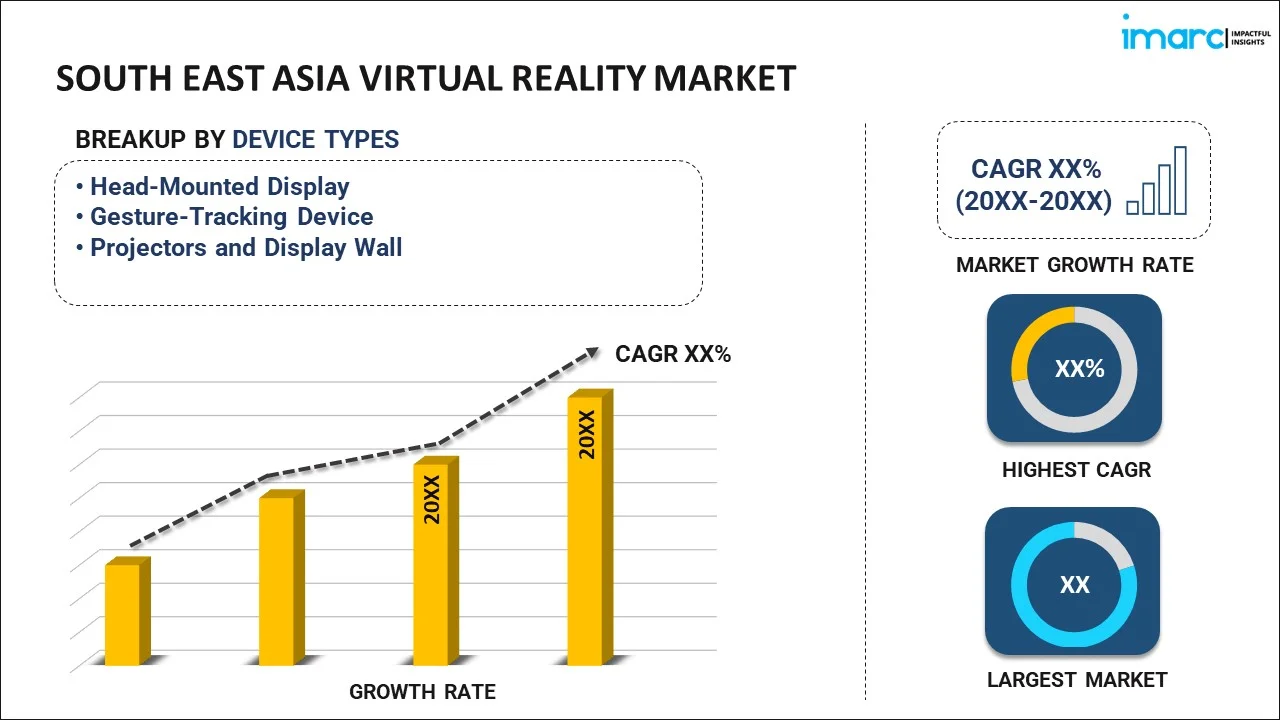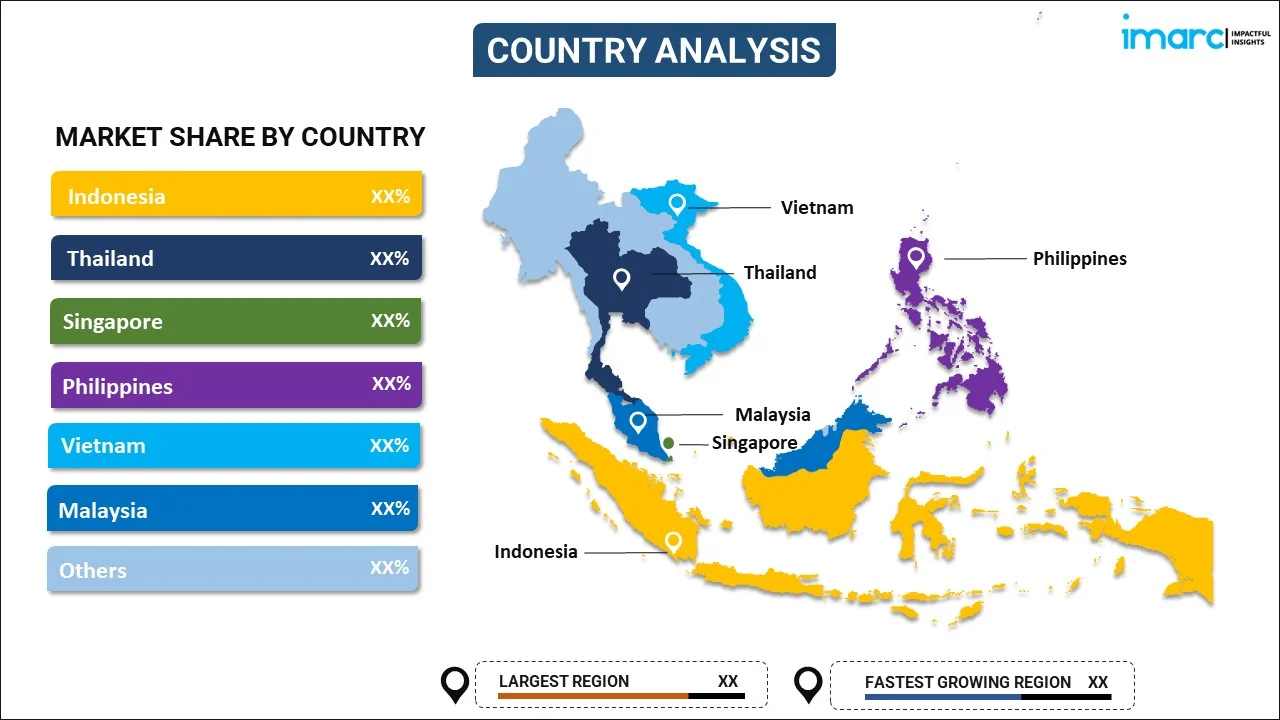
South East Asia Virtual Reality Market Report by Device Type (Head-Mounted Display, Gesture-Tracking Device, Projectors and Display Wall), Technology (Semi and Fully Immersive, Non-Immersive), Component (Hardware, Software), Application (Aerospace and Defense, Consumer, Commercial, Enterprise, Healthcare, and Others), and Country 2024-2032
Market Overview:
South East Asia virtual reality market size is projected to exhibit a growth rate (CAGR) of 20.30% during 2024-2032. The expanding gaming and entertainment industry, along with the inflating need among leading players for providing unique and interactive entertainment experiences to individuals, is primarily driving the market growth.
|
Report Attribute
|
Key Statistics
|
|---|---|
|
Base Year
|
2023 |
|
Forecast Years
|
2024-2032 |
|
Historical Years
|
2018-2023
|
| Market Growth Rate (2024-2032) | 20.30% |
Virtual reality pertains to a computer-generated simulation or synthetic setting that individuals can engage with. This technology incorporates specialized head-mounted goggles featuring display screens integrated with sensors, enabling users to interact with and explore virtual environments, manipulate digital objects, and engage with simulated characters or elements in a three-dimensional (3D) realm. In line with this, the technology delivers an incredibly engaging and interactive virtual encounter by integrating hardware, software, and sensory inputs. Consequently, virtual reality finds extensive applications in various industries, including gaming, entertainment, education, healthcare, and aerospace and defense.
South East Asia Virtual Reality Market Trends:
The virtual reality market in South East Asia is currently witnessing substantial growth, primarily driven by the heightened integration of virtual reality within the education sector to foster interactive learning experiences for students. Additionally, the increasing demand for virtual reality technologies, attributed to the declining costs of virtual reality devices on a wide scale, is fostering a positive market projection within the region. Correspondingly, the growing utilization of virtual reality in the field of architecture, engineering, and construction (AEC) for advanced product design, prototyping, and visualization, resulting in heightened efficiency and cost reduction, is significantly contributing to the expansion of the market. Moreover, the rising adoption of virtual reality within corporate offices for remote and virtual meetings is serving as a catalyst for market growth, offering enhanced connectivity and collaboration opportunities for businesses across South East Asia. Furthermore, the escalating demand for virtual reality solutions within the travel and tourism industry, enabling virtual tours of hotels, resorts, and various tourist attractions, is playing a crucial role in supporting the expansion of the market within the region. This integration is providing consumers with immersive and engaging experiences, which is expected to augment the overall growth of the virtual reality market in South East Asia over the forecasted period.
South East Asia Virtual Reality Market Segmentation:
IMARC Group provides an analysis of the key trends in each segment of the market, along with forecasts at the regional and country levels for 2024-2032. Our report has categorized the market based on device type, technology, component, and application.
Device Type Insights:

- Head-Mounted Display
- Gesture-Tracking Device
- Projectors and Display Wall
The report has provided a detailed breakup and analysis of the market based on the device type. This includes head-mounted display, gesture-tracking device, and projectors and display wall.
Technology Insights:
- Semi and Fully Immersive
- Non-Immersive
A detailed breakup and analysis of the market based on the technology have also been provided in the report. This includes semi and fully immersive and non-immersive.
Component Insights:
- Hardware
- Software
The report has provided a detailed breakup and analysis of the market based on the component. This includes hardware and software.
Application Insights:
- Aerospace and Defense
- Consumer
- Commercial
- Enterprise
- Healthcare
- Others
A detailed breakup and analysis of the market based on the application have also been provided in the report. This includes aerospace and defense, consumer, commercial, enterprise, healthcare, and others.
Country Insights:

- Indonesia
- Thailand
- Singapore
- Philippines
- Vietnam
- Malaysia
- Others
The report has also provided a comprehensive analysis of all the major regional markets, which include Indonesia, Thailand, Singapore, Philippines, Vietnam, Malaysia, and Others.
Competitive Landscape:
The market research report has also provided a comprehensive analysis of the competitive landscape. Competitive analysis such as market structure, key player positioning, top winning strategies, competitive dashboard, and company evaluation quadrant has been covered in the report. Also, detailed profiles of all major companies have been provided.
South East Asia Virtual Reality Market Report Coverage:
| Report Features | Details |
|---|---|
| Base Year of the Analysis | 2023 |
| Historical Period | 2018-2023 |
| Forecast Period | 2024-2032 |
| Units | US$ Million |
| Scope of the Report | Exploration of Historical Trends and Market Outlook, Industry Catalysts and Challenges, Segment-Wise Historical and Future Market Assessment:
|
| Device Types Covered | Head-Mounted Display, Gesture-Tracking Device, Projectors and Display Wall |
| Technologies Covered | Semi and Fully Immersive, Non-Immersive |
| Components Covered | Hardware, Software |
| Applications Covered | Aerospace and Defense, Consumer, Commercial, Enterprise, Healthcare, Others |
| Countries Covered | Indonesia, Thailand, Singapore, Philippines, Vietnam, Malaysia, Others |
| Customization Scope | 10% Free Customization |
| Report Price and Purchase Option | Single User License: US$ 3699 Five User License: US$ 4699 Corporate License: US$ 5699 |
| Post-Sale Analyst Support | 10-12 Weeks |
| Delivery Format | PDF and Excel through Email (We can also provide the editable version of the report in PPT/Word format on special request) |
Key Questions Answered in This Report:
- How has the South East Asia virtual reality market performed so far and how will it perform in the coming years?
- What has been the impact of COVID-19 on the South East Asia virtual reality market?
- What is the breakup of the South East Asia virtual reality market on the basis of device type?
- What is the breakup of the South East Asia virtual reality market on the basis of technology?
- What is the breakup of the South East Asia virtual reality market on the basis of component?
- What is the breakup of the South East Asia virtual reality market on the basis of application?
- What are the various stages in the value chain of the South East Asia virtual reality market?
- What are the key driving factors and challenges in the South East Asia virtual reality?
- What is the structure of the South East Asia virtual reality market and who are the key players?
- What is the degree of competition in the South East Asia virtual reality market?
Key Benefits for Stakeholders:
- IMARC’s industry report offers a comprehensive quantitative analysis of various market segments, historical and current market trends, market forecasts, and dynamics of the South East Asia virtual reality market from 2018-2032.
- The research report provides the latest information on the market drivers, challenges, and opportunities in the South East Asia virtual reality market.
- Porter's five forces analysis assist stakeholders in assessing the impact of new entrants, competitive rivalry, supplier power, buyer power, and the threat of substitution. It helps stakeholders to analyze the level of competition within the South East Asia virtual reality industry and its attractiveness.
- Competitive landscape allows stakeholders to understand their competitive environment and provides an insight into the current positions of key players in the market.
Need more help?
- Speak to our experienced analysts for insights on the current market scenarios.
- Include additional segments and countries to customize the report as per your requirement.
- Gain an unparalleled competitive advantage in your domain by understanding how to utilize the report and positively impacting your operations and revenue.
- For further assistance, please connect with our analysts.
 Inquire Before Buying
Inquire Before Buying
 Speak to an Analyst
Speak to an Analyst
 Request Brochure
Request Brochure
 Request Customization
Request Customization




.webp)




.webp)












